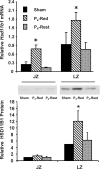Changes in the placental glucocorticoid barrier during rat pregnancy: impact on placental corticosterone levels and regulation by progesterone
- PMID: 19208548
- PMCID: PMC2849810
- DOI: 10.1095/biolreprod.108.073650
Changes in the placental glucocorticoid barrier during rat pregnancy: impact on placental corticosterone levels and regulation by progesterone
Abstract
Glucocorticoid excess in utero inhibits fetal growth and programs adverse outcomes in adult offspring. Access of maternal glucocorticoid to the glucocorticoid receptor (NR3C1) in the placenta and fetus is regulated by metabolism via the 11beta-hydroxysteroid dehydrogenase (HSD11B) enzymes, as well as multidrug resistance P-glycoprotein (ABCB1)-mediated efflux of glucocorticoids from the syncytiotrophoblast. This study determined expression of genes encoding the two HSD11B isoforms (Hsd11b1 and Hsd11b2), the two ABCB1 isoforms (Abcb1a and Abcb1b), and Nr3c1 in the junctional and labyrinth zones of rat placentas at Days 16 and 22 of normal gestation (Day 23 is term). To assess possible regulation of the Hsd11b and Abcb1 isoforms by glucocorticoids and progesterone, their placental expression was also measured at Day 22 after partial progesterone withdrawal from Day 16 (maternal ovariectomy plus full estrogen and partial progesterone replacement) or after treatment with dexamethasone acetate (1 microg/ml of drinking water from Day 13). Expression of Hsd11b1 mRNA increased in the labyrinth zone (the site of maternal-fetal exchange) from Day 16 to Day 22, whereas that of Hsd11b2 fell dramatically. Consistent with these changes, corticosterone levels increased 10-fold in the labyrinth zone over this period. Expression of both Abcb1a and Abcb1b was markedly higher in the labyrinth zone compared with the junctional zone on both days, consistent with the proposed barrier role of ABCB1 in the placenta. Nr3c1 mRNA expression was similar in the two placental zones at Day 16 but increased 3-fold in the labyrinth zone by Day 22. Partial progesterone withdrawal increased Hsd11b1 mRNA and protein expression in the labyrinth zone but decreased Nr3c1 mRNA expression. These data show that the dynamic expression patterns of the placental HSD11Bs in late gestation are associated with dramatic shifts in placental corticosterone. Moreover, the late gestational rise in labyrinthine Hsd11b1 seems to be driven by the normal prepartum fall in progesterone level.
Figures





Similar articles
-
Multidrug resistance phosphoglycoprotein (ABCB1) in the mouse placenta: fetal protection.Biol Reprod. 2005 Oct;73(4):591-7. doi: 10.1095/biolreprod.105.042242. Epub 2005 May 25. Biol Reprod. 2005. PMID: 15917342
-
Altered placental development in undernourished rats: role of maternal glucocorticoids.Reprod Biol Endocrinol. 2011 Aug 1;9:105. doi: 10.1186/1477-7827-9-105. Reprod Biol Endocrinol. 2011. PMID: 21806804 Free PMC article.
-
Tissue-specific messenger ribonucleic acid expression of 11beta-hydroxysteroid dehydrogenase types 1 and 2 and the glucocorticoid receptor within rat placenta suggests exquisite local control of glucocorticoid action.Endocrinology. 1998 Apr;139(4):1517-23. doi: 10.1210/endo.139.4.5900. Endocrinology. 1998. PMID: 9528929
-
Dual function of 11beta-hydroxysteroid dehydrogenase in placenta: modulating placental glucocorticoid passage and local steroid action.Biol Reprod. 1999 Feb;60(2):234-40. doi: 10.1095/biolreprod60.2.234. Biol Reprod. 1999. PMID: 9915986 Review.
-
Mechanisms for establishment of the placental glucocorticoid barrier, a guard for life.Cell Mol Life Sci. 2019 Jan;76(1):13-26. doi: 10.1007/s00018-018-2918-5. Epub 2018 Sep 17. Cell Mol Life Sci. 2019. PMID: 30225585 Free PMC article. Review.
Cited by
-
Ligand-receptor interaction between triterpenoids and the 11beta-hydroxysteroid dehydrogenase type 2 (11betaHSD2) enzyme predicts their toxic effects against tumorigenic r/m HM-SFME-1 cells.J Biol Chem. 2011 Oct 21;286(42):36888-97. doi: 10.1074/jbc.M111.265900. Epub 2011 Aug 31. J Biol Chem. 2011. PMID: 21880714 Free PMC article.
-
Epigenetic effects of prenatal stress on 11β-hydroxysteroid dehydrogenase-2 in the placenta and fetal brain.PLoS One. 2012;7(6):e39791. doi: 10.1371/journal.pone.0039791. Epub 2012 Jun 26. PLoS One. 2012. PMID: 22761903 Free PMC article.
-
Developmental Lead Exposure and Prenatal Stress Result in Sex-Specific Reprograming of Adult Stress Physiology and Epigenetic Profiles in Brain.Toxicol Sci. 2018 Jun 1;163(2):478-489. doi: 10.1093/toxsci/kfy046. Toxicol Sci. 2018. PMID: 29481626 Free PMC article.
-
In utero exposure to ultrafine particles promotes placental stress-induced programming of renin-angiotensin system-related elements in the offspring results in altered blood pressure in adult mice.Part Fibre Toxicol. 2019 Jan 28;16(1):7. doi: 10.1186/s12989-019-0289-1. Part Fibre Toxicol. 2019. PMID: 30691489 Free PMC article.
-
Juvenile offspring of rats exposed to restraint stress in late gestation have impaired cognitive performance and dysregulated progestogen formation.Stress. 2011 Jan;14(1):23-32. doi: 10.3109/10253890.2010.512375. Epub 2010 Oct 31. Stress. 2011. PMID: 21034292 Free PMC article.
References
-
- McIntire DD, Bloom SL, Casey BM, Leveno KJ.Birth weight in relation to morbidity and mortality among newborn infants. N Engl J Med 1999; 340: 1234–1238. - PubMed
-
- Seckl JR.Glucocorticoid programming of the fetus; adult phenotypes and molecular mechanisms. Mol Cell Endocrinol 2001; 185: 61–71. - PubMed
-
- Gluckman PD, Hanson MA.Living with the past: evolution, development, and patterns of disease. Science 2004; 305: 1733–1736. - PubMed
-
- Yang K.Placental 11beta-hydroxysteroid dehydrogenase: barrier to maternal glucocorticoids. Rev Reprod 1997; 2: 129–132. - PubMed
-
- Burton PJ, Waddell BJ.Dual function of 11beta-hydroxysteroid dehydrogenase in placenta: modulating placental glucocorticoid passage and local steroid action. Biol Reprod 1999; 60: 234–240. - PubMed
Publication types
MeSH terms
Substances
LinkOut - more resources
Full Text Sources

